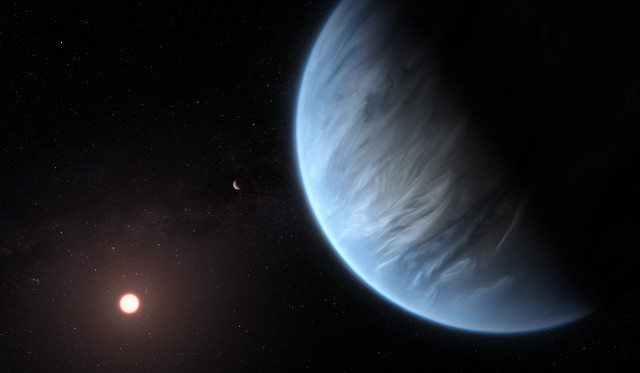
An article published in the journal “Nature Astronomy” reports the detection of water vapor in the exoplanet K2-18b’s atmosphere mainly thanks to the Hubble space telescope. This exoplanet is in its system’s habitable zone and this made it interesting since this super-Earth was discovered in 2015. It’s the first detection of water vapor in an exoplanet of that type but it’s still too soon to assess its habitability potential because the detections are not precise enough to define the percentages of other molecules such as hydrogen and helium and to understand if there are clouds.
About 111 light-years from Earth, the exoplanet K2-18b orbits a red dwarf with a mass that is about 40% of that of the Sun and consequently is much colder. With a year that lasts only 33 days on Earth, K2-18b is in its system’s habitable zone but could be hit by radiation emitted by its star, small but active with powerful flares.
The exoplanet K2-18b has been an object of interest since its discovery and already the authors of an article published in the journal “Astronomy & Astrophysics” in December 2017 tried to better understand its characteristics. Its radius is about 2.24 times the Earth’s and its mass is probably around 8 times the Earth’s and that’s why Dr. Angelos Tsiaras of University College London (UCL), first author of the article published in “Nature Astronomy”, stated that it’s not “Earth 2.0” but brings us closer to answering the fundamental question: is the Earth unique?
Various observations of the K2-18b exoplanet have been carried out using the Hubble Space Telescope between 2016 and 2017. The authors of this research put together the data collected and developed an algorithm to analyze the light of its star filtered through the planet’s atmosphere. That allowed to find the chemical signatures of water vapor indicating the presence of hydrogen and helium as well. According to the researchers other molecules such as nitrogen and methane may be present but remain undetectable with current observations. More studies are needed to understand if there are clouds and the percentage of water vapor in the atmosphere.
Among the members of the team that carried out this research there’s Professor Giovanna Tinetti of UCL, an expert in exoplanets to the point that she’s the principal investigator of ESA’s ARIEL mission (Atmospheric Remote-sensing Infrared Exoplanet Large-survey), a space telescope scheduled for launch in 2028 which has precisely the purpose of studying exoplanets’ atmospheres. Regarding K2-18b she stated that this is one of the most interesting targets for future studies.
Dr. Ingo Waldmann of UCL, another author of this research, pointed out that this is probably the first of many discoveries of potentially habitable planets. This is not only because super-Earths like K2-18b are the most common planets in the Milky Way but also because red dwarfs are the most common stars.
This kind of discovery always raises the hope of having found the alleged Earth’s twin but prudence is needed. Despite all the progress made, the study of exoplanets began just over twenty years ago and the information we can get about them is still limited. The TESS space telescope continues to discover new exoplanets and future missions such as ARIEL but also the James Webb space telescope will help to obtain much more data to understand which exoplanets are really habitable for life forms similar to the Earth’s.


Permalink